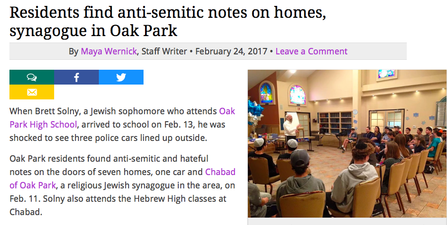 A screenshot of a recent article about anti-Semitic messages in a local community by one of my student journalists. I’ve challenged my reporters to think about how they can move from conveying information to helping readers’ understanding. A screenshot of a recent article about anti-Semitic messages in a local community by one of my student journalists. I’ve challenged my reporters to think about how they can move from conveying information to helping readers’ understanding. My student newspaper staff has a dilemma: how can they get their peers to read the paper when so much of the information in our articles is already known? They are coming up against a problem professional journalists have been struggling with for years. In the old days (I won’t call them good, as I think that’s always relative), news producers — whether newspaper, radio or broadcast — were the source of information. News consumers found out about terrorists attack and new government policies when they opened the morning paper or turned on the evening news. With the advent of the Internet and social media, however, those gatekeepers lost control. Now people have more information than they know what to do with. This flood of data creates a number of problems — especially in terms of helping people separate fact from fiction — but I want to focus today on the issue it creates in terms of engagement. If news consumers have the facts about an event — or at least think they do — why should they care when the paper publishes a story about it? We hope they care because they trust traditional news sources to have a vetting process for their stories; unlike Tweets at 2 a.m., these stories have been fact-checked and include a variety of primary and expert sources to ensure truthfulness in a holistic sense. News literate consumers know the value of good journalism, we hope, and will therefore seek it out.
But beyond getting the facts right, good journalism has a larger responsibility to serve as sense-maker. "When most readers say they expect journalists to tell them what’s happening — whether that’s the latest outrages reported out of Kharkiv or city council in Kalamazoo — they mean connect the dots,” Ken Doctor writes. "No, they don’t want opinion — they want to know how the facts fit together to make an understandable whole." This is what sets major news sources such as the New York Times apart from local news sources, Doctor argues. "It’s authority,” he writes. "You read the Times to understand. Sometimes it does a better job of that than others, but its great success in reader revenue shows us its audience gets that part of the value equation. Yes, readers can get the facts of the Gaza War free in so many places, but they can’t get a volume of rich, contextual stories from both sides of the conflict elsewhere every day." In his essay "Journalism’s Moral Responsibility: Three Questions,” Bill Mitchell argues that journalism has a moral obligation to cover important stories and help readers understand their importance. He poses three crucial questions:
The key, he argues, is to make important news salient. "In moral journalism, salient is more than important, interesting, or relevant. It's more than selling a story that no one would otherwise read, or dumping it on an ignorant world with the righteous justification that it ought to be read. For journalists, Salient is a moral term, not a marketing one,” he writes. "Our moral responsibility is to cover significant threats to well-being, substantively, in such a way that our coverage leaps out, protrudes, and is strikingly and conspicuously prominent. So that it sears the conscience of our fellow citizens." He points to Laurel Leff’s research on the Times’ coverage of the Holocaust during 1939-1945. Leff found that the Times did cover the Holocaust, but that coverage tended to be on inside pages and was missing in editorial commentary and summaries of important news. In her report, Leff writes, “Despite the detailed, credible information that was available, the American public actually did not know about the Holocaust while it was happening because mainstream American newspapers never presented the story of the extermination of the Jews in a way that highlighted its importance.” In other words, Mitchell concludes, "the Times had the story. It just didn't make it salient." Mitchell’s essay is aimed at national and global news sources and news events on a much larger scale than those typical at a high school, clearly, but I believe this raises important questions for the moral responsibilities of scholastic journalists. If they want their reporting to matter — if they want their peers to read more than the humor columns or restaurant reviews — they must make their reporting on important topics salient to their peers. Here is my suggestion for reworking Mitchell’s three questions for a scholastic journalism staff:
Although these questions are not a complete solution, they are a starting point for creating greater engagement without abandoning the most important stories.
2 Comments
|
About“And though she be but little, she is fierce!” -A Midsummer Night’s Dream Archives
December 2020
Categories
All
|

 RSS Feed
RSS Feed